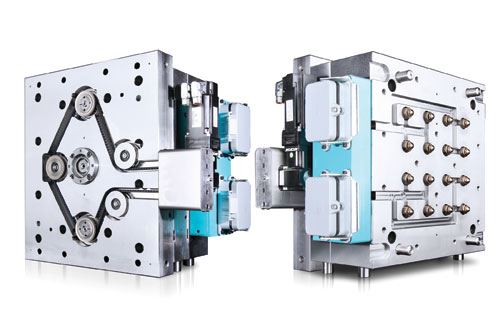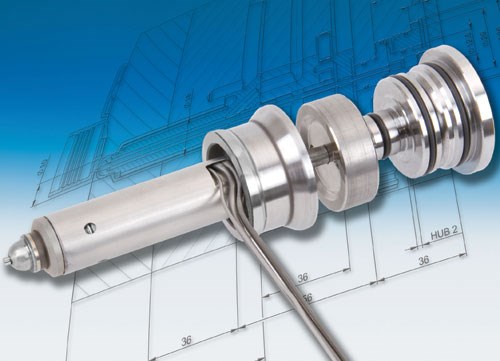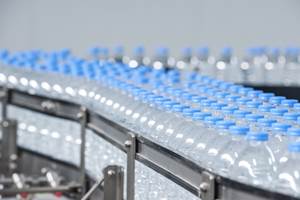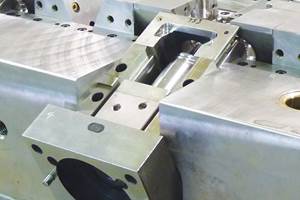Simplify and Streamline
Technology suppliers discuss how equipment speeds time-to-market.
Just as mold manufacturers are constantly looking for ways to streamline the mold design and build process while maintaining quality and accuracy as molds get more complex, they also wish to reduce the amount of suppliers with which they deal. It is more important than ever that a supplier not only sell equipment—but offer a variety and possess a working knowledge of the moldmaking process.
Hot runner and components suppliers are listening to their customers. Hot runner systems and mold components are becoming more streamlined and standardized—increasing productivity, reducing maintenance and improving efficiencies.
According to Dave Lange, Director of Sales at DME Company (Madison Heights, MI), moldmakers face application hurdles that include: challenging part shape/geometry, required higher cavitations and volume and in-mold assembly, increased end market regulations and improved part cosmetics. “All of the advances we are seeing in hot runners, components and anything else relating to moldmaking are coming from customer demand for reduced overall tooling costs, reduced design time and overall leadtime,” Lange states. Below, a number of major suppliers join Lange in weighing in on where they believe the markets are heading.
Challenges
Michael Ellis, Director, Sales Support and Marketing for Mold-Masters Ltd. (Georgetown, ON), notes that the most common questions molders and moldmakers ask the company is regarding materials used, hot runner balance and warranties. “Variables, such as material toughness, wear rates, thermal profile, etc. are all key to a moldmaker’s ability to create a good, durable and long-lasting mold,” he elaborates. “Something that is critical in ensuring that their customers—the molders and end users—maximize the uptime of their molding processes. This is why we spend so much time testing and developing new materials and designs that continuously increase the longevity of our systems.”
Hot runner balance is key in order to mold a good part, Ellis continues, affecting everything from part fill rate to color change. “A variety of factors affects hot runner balance, but the manufacturing of the manifold and the thermal profile of the entire system are two variables that have the most impact,” he states. “Because we use brazed-in heaters with optimal heat profile, plus our nozzle design allows for thermocouples to be installed close to the gate for accurate thermal readings, our entire hot runner system ensures an accurate heat profile. We have also developed special technology manifolds to ensure that all internal runners are optimized with no sharp corners or dead zones—allowing the melt to flow through the channels without any obstructions.”
Moldmakers commonly ask Synventive Molding Solutions (Peabody, MA) what the company can do to help them keep down costs and simplify installations, notes its Chief Engineer Bill Rousseau. “Synventive puts a strong emphasis on satisfying this request with everything we develop, including a product that greatly reduces the time required to integrate a valve gate hot runner into the mold and prepare it for first article testing,” he states.”
Tony Brusca, President of Alba Enterprises Inc. (Rancho Cucamonga, CA), notes that his customers ask questions like how fast can they get a quote; and can Alba process high-end technical materials.
Over at HASCO America, Inc. (Fletcher, NC), Brenda Clark, Applications Engineer and Inside Sales Manager, says the common moldmaker questions are about applications in areas like cost reduction, increased productivity, cleanroom technology, improved service life, maintainability, cycle time abbreviation, reduction of wear and improved energy efficiency.
Advancements
Lange of DME notes that hot runner technology advancements will focus more on cost- effective, integrated solutions over the next year. “With the continued movement of molds around the globe—offshore tooling coming back to North America and domestic tooling moving overseas—hot runner technology will have to meet strict demands on standard features and timing to give OEMs the competitive advantage they are looking for in getting to market first with a new product, meeting increased consumer demand, etc.,” he comments. “We are also seeing advancements in hot runner component wear characteristics and improved thermal heat profiles for processing sensitive, filled, engineering grade resins.
“We’re working to add to our product lines in ways that accommodate moldmakers’ and designers’ needs to cut costs and save time,” Lange continues. “Our new unitized open gate hot runner system is designed for customers who might not need a full hot half, but are looking for a complete, pre-wired assembly. This means responsibility for the system still sits with DME, allowing customers to save leadtime and costs.”
Tips and heating elements on new hot runner systems will provide better thermal heat profiles in the critical areas of the nozzle and tip, according to Lange. “All of these introductions bring us closer to offering global product platforms,” he states. “Customers with multiple locations benefit from global replacement parts, standardization across all operations and simplified mold design by eliminating region-specific design characteristics.”
The company also is focusing on working with resin suppliers in its hot runner lab on processing new resins. “By working together with them on technologies and processes that improve flow and gate cosmetics and reduced sheer (when appropriate), we are serving as a more encompassing partner for our customers—meeting their desire for working with fewer suppliers, who can do more.”
Synventive’s Rousseau notes a significant recent advancement is “advanced flow control” technology, which gives the molder the ability to have a level of control over the movement of the valve pins beyond the traditional open/close. “There are multiple technologies now available giving the molder different levels of advanced flow control,” he explains. “While these technologies are aimed at the molder, some can offer significant benefits to the moldmaker as well. For example, we have introduced an electric actuator that can give the molder more control, better repeatability, cleaner operation and better energy efficiency. This can also be advantageous to the moldmaker. Because it’s completely electric there is no plumbing, bleeding or even wiring. Supplied cables connect the actuators to a prewired junction box making installation quick and easy. The wires are much smaller than traditional plumbing lines—requiring much smaller slots to exit them to the junction box saving on machining time and helping to maintain the structural integrity of the tool.”
Over at Mold-Masters, Ellis sees two key areas of development: new opportunities to hot runner parts that were previously molded or manufactured differently; and perfecting the part production process through new, innovative products and technologies. “Looking at the first area we believe there is major potential in changing the way plastic parts with multi-material components are made,” Ellis says. “These parts are usually found in the food industry and vary from plastic bottle closures with barrier liners (such as sports drink bottles) to thin-wall packaging containers such as thermoformed pudding/fruit cups to canned pet food or tuna. Barriers are used in these products to protect the food and ensure a long shelf life. Without the barrier the product will spoil. Very little development has been done to prevent permeation through these containers, other than liners added by a secondary process. Closures with barrier (such as for sport or energy drinks) are typically done in a two-stage process where the barrier liner is assembled into the closure after the closure is injection molded. Thin-wall containers are typically made by thermoforming many layers of material, a process with a high degree of material waste and a high energy demand. Similar thin-walled parts are also canned—a process entirely independent of the plastics industry.”
To address this challenge, Mold-Masters has developed a one-stage, energy-efficient, injection-molded process. “It completely redefines co-injection technology,” he states. “It uses multi-level flow manifolds—plus a specially designed nozzle and valve gate assembly—to create a totally new way of using hot runners to co-inject two materials into one part. This technology, when used with our controller, ensures the precise control to inject a specified layer of 3 to 4 percent EVOH barrier into the part. The layer is a very balanced, thin layer that is controlled, or sandwiched, within the walls of the plastic part.”
Ellis explains that this process will result in new work for moldmakers and injection molders. “Replacing closures with liners and co-injected closures with barrier changes the way a closure mold is made, providing the moldmaker with more flexibility in their design (in terms of cycle time, wall thickness, etc.) because they don’t have to allow for liner insertion.”
To address the second area of development, advancing the part production process, Mold-Masters has been working on numerous designs that provide moldmakers and molders more flexibility in their part design thus improving their production rates. A side gate design has been developed for deep draw parts like pipettes and syringe barrels, and allows for 20 percent higher pitch density compared to other designs, Ellis notes. A new line of tips and seals prolongs wear resistance, but also optimizes thermal control.
Kosmas G. Kasimatis, General Manager at Melt Design, Inc. (MDi; St. Charles, IL), says that the company is focusing on its customers’ need to improve the quality of their end product, while dealing with the current worldwide economic crisis. “The increased awareness among processors regarding the quality of the melt, after it exits the extruder and as it is distributed in the hot runner, is critical,” Kasimatis stresses. “If compromised, it may yield an inferior product. On another note, injection molders have realized the benefits of sustainability and a sustainable operation as a means to circumvent the financial crisis. The general direction is that processors want to increase the amount of re-grind, while at the same time increase product quality.”
The main benefit to the moldmaker, Kasimatis adds, is that the dual filter will prevent the mold from being damaged from debris, such as metal shavings, etc. that could potentially enter the mold cavity(ies).
Another area Melt-Design has addressed is with molds for thin-walled articles like pipettes, needles and feminine hygiene products, Kasimatis adds. “We have developed a 90-degree direct gating system for tall, thin-walled items that simplifies and greatly reduces mold building cost by up to 50 percent while also eliminating the need for split cavities. The mold can be assembled in a fraction of the time it takes to assemble circularly-arranged cavity layouts.”
INCOE® Corp. (Troy, MI) is focusing on continuous improvement. “This covers all aspects necessary to meet or exceed the customers’ goals,” notes INCOE North America Sales Manager Jim Bott. “We embrace change as good. Specifically, understanding and using the entire capabilities of technologies involved with software simulations, melt management, machining centers, order entry to plastic part production logistics, tooling and raw materials. And, most importantly, the hiring and training of highly skilled professionals.”
Some of the advancements introduced by INCOE include a technology designed for improvements in part quality requiring sequential molding; and others are “solutions-approach” products, Bott notes. “The desire is to make the purchase, communication, technology and hardware readily available to the mold designer, seamless to the moldmaker and ‘invisible’ to the molder, ”he says,“ all the while providing the lowest price/performance ratio, expedited to the market.”
The Hot Runner Division at HASCO has introduced a hydraulically operated cylinder for the motion of the needle valve packages that improves the maintenance friendliness of the system because dismantling it can be done without exposing the hydraulic drive unit, Clark explains. As a result, the system and surrounding environment are protected from contamination with hydraulic oil.
“An additional drive solution for needle valve plates is the servo motor control that features a control technology especially developed for plastics processors,” Clark comments. “A modular range of needle valves for individual pneumatic and hydraulic control in different housing variants round off the new drive unit portfolio. Also new is a needle valve nozzle for the packaging sector with substantial process and service-optimized features and new nozzle lengths.
“Through these developments, emphasis is placed on using the latest technologies for improving efficiency and productivity, and also on identifying every possibility for reducing costs,” Clark adds.
Trends Alba’s Brusca sees include faster access to CAD files and pricing. “As for technology, heat profiles on manifolds and nozzles as well as tip designs for special applications, in addition to faster turnaround for designs in special applications,” he notes.
Research these simplified, streamlined technologies to determine what will work best in your shop. Partnering with the suppliers of these products can result in higher productivity and reduced time-to market while increasing efficiencies.
Related Content
MoldMaking Technology's Most-Viewed Content 2022: Products
MMT shares the five top-viewed technologies, equipment and services of 2022 in each Engineer, Build, Maintain and Manage tenet based on Google Analytics.
Read MoreWhat is Driving Mold Lifecycle Management Digitalization?
OEMs are looking to partner with suppliers to share and track data across the supply chain for advanced intervention and process management.
Read MoreProducts and Services for Multiple Moldmaking Needs
New year, new technology roundup! Featured here is a collection of product offerings, from profile milling cutters to industry-specific CAD/CAM software to innovative hot work tool steels.
Read MoreHow to Solve Core Pull Flash and Part Issues
Many mold problems can be solved by simply providing enough preload force on the core to prevent movement.
Read MoreRead Next
Hot Stuff!
Advances in valve gating technologies and improved efficiencies heat up the hot runner market in 2005.
Read MoreAre You a Moldmaker Considering 3D Printing? Consider the 3D Printing Workshop at NPE2024
Presentations will cover 3D printing for mold tooling, material innovation, product development, bridge production and full-scale, high-volume additive manufacturing.
Read MoreHow to Use Strategic Planning Tools, Data to Manage the Human Side of Business
Q&A with Marion Wells, MMT EAB member and founder of Human Asset Management.
Read More














.png;maxWidth=300;quality=90)






_300x250 3.png;maxWidth=300;quality=90)







